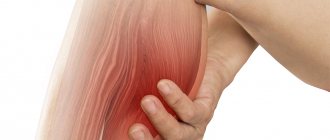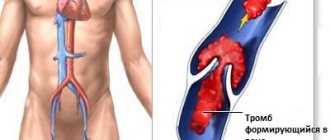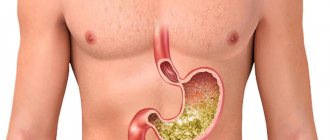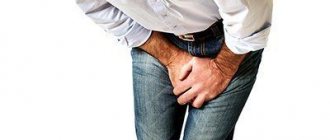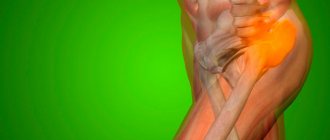Testicular pain in men is usually accompanied by pain in the groin area. The most common cause of this symptom is prostatitis - acute or chronic inflammation of the prostate gland. In addition to pain, a man experiences urinary disturbances: pain, burning, false urges, weakening of the urine stream.
Sharp pain can occur with testicular torsion associated with sudden movements during sports. Half of the scrotum quickly increases in size due to swelling, the temperature rises, nausea and vomiting occur.
Other possible reasons why the testicles and abdomen hurt:
- epididymitis and orchitis (inflammation of the epididymis);
- spermatocele (spermatic cord cyst, which is more common in old age);
- inguinal hernia, congenital or acquired;
- sexually transmitted infections (for example, if you recently had casual sexual intercourse);
- adenoma or malignant tumor of the prostate;
- hydrocele (serous fluid between the membranes of the testicle).
Strong excitement
Another reason could be severe overexcitation, after which there was no ejaculation. Due to the fact that the seminal fluid is not released, a strong spasm occurs, manifested by pain. Fullness of the testicles causes unpleasant symptoms. But the pain here is not sharp, but aching and pulling.
The physiological nature of the symptom, which does not require urgent medical attention, is indicated by the following signs:
- the pain is nagging, moderate and not accompanied by general malaise or fever;
- there are no rashes, redness, or swelling on the skin of the scrotum;
- the process of urination is not disturbed, the color of urine is not changed.
Diseases of the musculoskeletal system
ARS syndrome is inflammation and degeneration of tendons and ligaments attached to the pubic bone and symphysis. Athletes face this. Pain is observed in the lower abdomen and groin area, intensifying with hip abduction.
Hip sprain. May be caused by a fall or sudden abduction of the hip while performing any exercise.
Coxarthrosis, arthropathy, femoral neck fracture. These are diseases associated with damage or disease to the hip joint and the proximal part of the femur where it attaches to the joint.
Why does a man's right or left testicle hurt?
The most common cause of pain in the left testicle in men is varicocele - dilation of the veins of the spermatic cord. In 80% of cases, the disease manifests itself on the left side. For this reason, the pain radiates to the left testicle. It can also hurt with pyelonephritis, urolithiasis and intestinal infections.
Pain in the right testicle in men is associated with torsion of the spermatic cord. Varicocele occurs on the right side less often than on the left, but the possibility cannot be completely excluded. Also, pain can occur for any of the reasons listed above if the inflammation affects only the right testicle.
Diagnostics
Determining the nature of the pathology is the responsibility of a urologist-andrologist. During the interview, the specialist clarifies when and under what circumstances the pain in the scrotum arose, what symptoms were accompanied, and how the disease developed over time. The examination program may include the following diagnostic procedures:
- Visual inspection.
Provides for assessing the condition of the external genitalia, detecting edema, hyperemia, cyanosis, local hyperthermia, dilated veins and other changes. During palpation, the condition of the testicle and other structures of the scrotum is assessed, and enlarged inguinal lymph nodes are identified. - Diaphanoscopy.
Carried out as part of the initial appointment. Makes it possible to differentiate fluid accumulation from other pathologies accompanied by an increase in the volume of the scrotum. - Ultrasonography.
Informative and safe basic research. An ultrasound of the scrotum reveals inflammatory changes, tumors, hematomas, hemorrhages, and testicular torsion. To assess the condition of the vessels, Doppler ultrasound is additionally performed. - Scintigraphy.
Can be static and dynamic. In the first case, structural disorders are determined, in the second, blood flow is assessed. The technique is used for traumatic injuries, inflammatory processes, vascular damage, and neoplasms. - Scrotal puncture.
Performed to identify fluid. Allows you to confirm the presence of spermatocele and hydrocele, to distinguish between these conditions with hemorrhages, neoplasia and hernial protrusions. - Lab tests.
Based on the results of a general blood test, inflammation is confirmed and the severity of anemia in tumors and injuries is assessed. For STIs, ELISA and PCR are performed. In case of dysuria or suspected diseases of the urinary system, general and biochemical urine tests may be indicated. The material obtained during punctures and biopsies is studied by histological or morphological examination.
Consultation with a urologist-andrologist
Which doctor should I contact if my testicle hurts?
If you encounter such a symptom, you need to contact a urologist or andrologist. The competence of these specialists includes the diagnosis and treatment of diseases of the genitourinary and reproductive systems. At the clinic Dr. AkNer employs specialists with extensive experience, and also has all the necessary equipment for a complete examination. Already at the initial consultation you will understand the tactics of diagnosis and subsequent treatment. To make an appointment, write to us in the online form or call our contact numbers at a convenient time.
Epidymitis
Male weakness - why testicles hurt
If you feel pain, but there were no injuries, then the reason may be different. The streams through which sperm flows become inflamed and require treatment. This disease is called epidymitis. In this case, you need rest and abstinence from sex.
If you have a testicular hernia, you will feel a feeling of fullness or swelling when standing. This weakens the tissues that separate the abdominal cavity from the scrotum. The hernia may become inflamed and then urgent surgery will be needed! Don't delay this!
Why does pain occur in the scrotum?
Lack of sexual release
Pain in the scrotum becomes a consequence of sexual arousal without subsequent release.
This condition is more common in adolescence and young adulthood and develops against the background of a combination of high libido and the absence of a sexual partner. In adults, it is observed when circumstances arise that prevent sexual relations, voluntary refusal of sex for religious reasons. A similar condition is observed in men who practice contraception by interrupting sexual intercourse, in patients suffering from orgasmic dysfunction. In all of these cases, the cause of pain is a rush of blood to the genitals without subsequent release of seminal fluid. The pain is dull, bursting, aching. May persist for several hours.
Inflammatory diseases
Pain in inflammatory diseases is combined with swelling, hyperemia, and hyperthermia. Caused by nonspecific bacterial infections, develops after injuries, invasive medical procedures. In children and adolescents, it may be a consequence of a viral infection: mumps, measles, rubella. It is detected in such pathologies as:
- Orchitis.
It occurs acutely or chronically. In the first case, it is accompanied by severe pain and symptoms of general intoxication. In the second, the condition is satisfactory, the pain is insignificant or moderate, dull, aching, nagging. There may be discharge from the urethra. - Epididymitis.
Rarely observed in isolation. May be combined with orchitis, urethritis. Clinical manifestations resemble orchitis, and can also be acute or chronic. - Epididymo-orchitis.
The acute form is manifested by hyperthermia up to 40 °C, sharp pain, aggravated by walking, radiating to the lower abdomen and lumbar region. In the chronic form, all symptoms are smoothed out. - Funiculitis.
It develops with inflammatory lesions of the testicle and its epididymis, and less often occurs in isolation. Characterized by pain, fever, thickening of the spermatic cord.
In case of immunity disorders or massive infection, acute forms of the listed diseases can develop into purulent inflammation. There is a deterioration in the condition, an increase in symptoms of intoxication, and increased pain that becomes twitching and throbbing. Along with nonspecific microflora, inflammation of the testicle, spermatic cord and epididymis can be caused by the following sexually transmitted diseases:
- gonorrhea;
- trichomoniasis;
- chlamydia;
- mycoplasmosis.
The clinical manifestations of specific infections vary. A typical feature is the discharge from the urethra of copious yellowish, greenish or whitish secretion with an unpleasant odor.
Pain in the scrotum
Purulent processes
Purulent inflammation can affect the organs or soft tissues of the scrotum, be local or widespread, occur primarily or develop as a result of the transfer of infection from nearby anatomical structures:
- Abscess of the scrotum.
Rare pathology. A limited abscess forms intrascrotally or in the area of superficial soft tissue. Increasing swelling is noted. The pain quickly intensifies, becomes jerking in nature, and disturbs night sleep. Body temperature rises to febrile levels. - Fournier's gangrene.
An extremely dangerous form of erysipelas with the formation of phlegmon and necrosis of the genital organs. It begins with general symptoms: weakness, fatigue, low-grade fever. After a few days, a painful area of compaction and redness appears in the scrotum. Local manifestations progress simultaneously with the worsening of general symptoms. When areas of necrosis appear, pain decreases due to the death of nerve endings. - Complication of prostate abscess
. A prostate abscess sometimes breaks into the urethra, rectum, scrotum, and nearby cellular spaces. A breakthrough occurs after a temporary improvement in the condition; if the scrotum is affected, it is accompanied by swelling, hyperemia, and severe pain.
Fluid accumulation
Dropsy can be widespread or limited. The following pathology options are distinguished:
- Hydrocele.
A common condition. Fluid accumulates between the vaginal membranes of the testicle. Discomfort and nagging pain appear when the volume of exudate reaches 300 ml or more, accompanied by an asymmetrical enlargement of the scrotum. - Spermatocele.
A seminal cyst forms in the area of the testicle or epididymis. It remains asymptomatic for a long time. The pain is associated with the accumulation of a large amount of fluid and suppuration of the cyst. - Funiculocele.
The spermatic cord cyst is also prone to asymptomatic progression. Minor nagging pain and a feeling of discomfort can be observed during sexual intercourse and physical activity.
Varicocele
Pain occurs at stage 2 of varicocele. The intensity of the discomfort varies significantly; some patients report mild pain or discomfort when walking, others complain of very sharp burning or shooting pains. There is a connection between pain and physical activity. Visually, dilation of the veins and sagging of the diseased half of the scrotum are detected. At stage 3, the pain becomes constant, occurs at rest, and bothers you at night. Scrotal asymmetry progresses.
Urgent conditions
Sudden sharp pain in the scrotum, radiating to the perineum and groin area, is the first symptom of testicular torsion. Due to unbearable pain, vomiting and collapse are possible. The scrotum is slightly enlarged, the affected testicle is located above the healthy one. The skin over the testicle is hyperemic, pale or bluish. Possible difficulty urinating, acute urinary retention.
Edema scrotal syndrome develops acutely with the accumulation of a large amount of effusion. Complicates injuries, inflammatory and non-inflammatory diseases of the scrotal organs, tumors, allergic reactions. The scrotum quickly increases in volume. The pain is so acute and intense that it is accompanied by vomiting, a drop in blood pressure, and the appearance of cold sweat.
Segmental testicular infarction is manifested by pain that increases over several days. With a total heart attack, the symptoms resemble testicular torsion or acute epididymo-orchitis. The intensity of the sensation reaches the level of painful shock. Patients are pale and covered in cold, sticky sweat. Tachycardia, hypotension are detected, and confusion is possible.
With closed injuries of the scrotal organs, the pain is also sharp, very intense, often accompanied by the development of pain shock. The scrotum is swollen, bluish with a purple or black tint, significantly increased in size. Hematocele, testicular dislocation, and sometimes with torsion may be observed. With open injuries to the scrotum, traumatic shock almost always develops against a background of pain and bleeding.
Neoplasms
Pain in the scrotum appears some time after the onset of the lump, sometimes combined with pain in the lower abdomen, and is detected in every fourth patient with a malignant testicular tumor. Observed in germ cell and non-germ cell neoplasia:
- seminoma;
- chorionic carcinoma;
- malignant teratoma;
- embryonal testicular cancer;
- sarcoma;
- leydigome;
- sertolioma.
The tumor increases in size, the scrotum becomes swollen. Subsequent symptoms are largely due to metastasis. Pain syndrome is not typical for benign tumors of the scrotum; it may appear during secondary infection due to the development of inflammation.
Parasitic pathologies
Parasitic diseases of the scrotum are typical for countries with tropical and subtropical climates. Filariasis is caused by helminths and provokes the development of elephantiasis due to damage to the lymphatic system of the genital organs. Pain in the scrotum occurs several years after infection and is often combined with hydrocele, epididymitis, and funiculitis. The pain is caused by dense swelling due to the accumulation of fluid in the tissues. Wuchereriosis is also accompanied by damage to the lymphatic vessels and elephantiasis. The weight of the scrotum in both diseases can reach 15-20 kilograms or more.
Other reasons
Sharp pain in the scrotum and groin area, nausea, vomiting, and deterioration in general condition occur when an inguinal-scrotal hernia is strangulated. Another possible cause of pain is irradiation from diseases of the rectum and genitourinary system. Radiating pain is observed in the following pathologies:
- prostatitis (congestive, calculous, etc.);
- prostate sclerosis;
- renal colic, including those caused by ureteral stones;
- occlusion of the ureter due to cancer of the kidney or ureter;
- proctitis
Consultation with a urologist
Treatment
Pre-hospital assistance
For patients with injuries, fixation with a suspensor or a special bandage and cold on the scrotum are indicated. For other conditions, jockstraps are often effective. In case of severe pain and absence of urgent pathology, a single dose of painkillers is possible. Other treatment methods are not indicated before diagnosis is made.
Conservative therapy
The following groups of drugs are prescribed:
- NSAIDs
. Reduces temperature, reduces inflammation and pain during inflammatory processes and traumatic injuries. - Antibiotics
. Indicated for purulent foci, inflammatory diseases, injuries. First, broad-spectrum drugs are prescribed. After receiving the results of the microbiological analysis, the antibiotic therapy regimen is adjusted. - Cytostatics.
Recommended for patients with non-seminoma cancer and late stages of seminoma. Supplemented with radiation therapy. - Antiparasitic agents
. Necessary for patients with wuchereriosis and filariasis.
For many diseases of the scrotum, wearing a suspensor is effective. If the pathology is secondary, treatment of the underlying disease is necessary. In the case of non-tumor processes, physiotherapeutic procedures may be prescribed.
